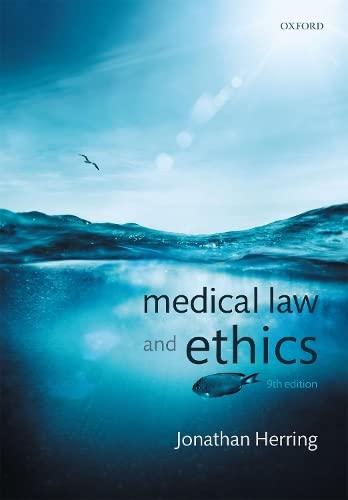Question
Instructions.Respond to each of the following Questions or Scenarios in brief paragraph form.The scenarios set forth are based on actual court cases and you will
Instructions.Respond to each of the following Questions or Scenarios in brief paragraph form.The scenarios set forth are based on actual court cases and you will be expected for some of the questions to research and review the actual decisions in those cases.Q1. (Max 11 points)Cynthia, a student at UC Berkeley, visited her hometown of Coalinga and, thereafter, wrote "An Ode to Coalinga" and posted it in her online journal at MySpace.Her page included her picture but did not contain her last name.The Ode told of how she despised her hometown and made a number of extremely negative comments about the town and its inhabitants.Six days after publishing her Ode on MySpace, Cynthia decided to remove it from her page.The principal of Coalinga High School, Roger Campbell, saw the Ode and decided to forward Cynthia's Ode to the local newspaper.The local newspaper decided to publish the Ode in its Letters to the Editor section and used Cynthia's full name in connection with it.The community reacted violently to the Ode and Cynthia's family was forced to close its local business and move out of town as a result.Cynthia and her family sued Mr. Campbell and the newspaper alleging that their public disclosure of the Ode violated their right-of-privacy.A. Find the case on the internet, identify the Plaintiff(s) and Defendant(s) in the case and identify the partie(s) that won the case.(4 points)B. Identify the particular privacy tort(s) that were considered to be relevant by the court.[Hint:It is not sufficient to simply state that the case involved "invasion of privacy."](3 points)C. Explain why the Court determined that Cynthia and her family's rights to privacy werenot violated. (4 points)Q2. (Max 14 points)A young man named Koffman, in his first year of organized football, was placed on the defensive team under the defensive coach, Wilson Garnett. To demonstrate proper tackling technique at practice one day, Coach Garnett, without warning, thrust himself into Koffman, picking him up and throwing him to the ground, thereby breaking Koffman's arm.Koffman filed a civil action and sued in tort for compensatory damages alleging that Garnett committed both an assault and a battery upon him.A. Set forth the correct elements of the civil action of assault.(3 points)B. Explain whether Koffman wins his case against Garnett for civil assault and why/why not.(4 points)C. Set forth the correct elements of the civil action of battery.(3 points)D. Explain whether Koffman wins his case against Garnett for civil battery and why/why not.(4 points)
Q3. (Max 10 points)The right of publicity is intended to protect the rights of persons, including celebrities, to profit from their "brand" and identities.Clearly, a supermarket that publishes an advertisement with the image of Michael Jordan, along with a red jersey with the number 23 emblazoned upon it can be held to violate Jordan's right of publicity if done without his consent.Does a person or celebrity, however, have a protectable interest in a song or catch phrase that may publicly be associated with, even though the image or likeness of the person/celebrity is not used?Read the case of Johnny Carson v. Here's Johnny Portable Toilets, Inc., 698 F.2d 831 (6th Cir. 1983) and answer the following questions:A.Did the trial court, i.e., the U.S. District Court, dismiss Appellant Carson's tort case based on his alleged right of publicity or did the trial court allow the right to publicity claim asserted by the Plaintiff to proceed to a jury?(2 points)B.Explain why the District Court ruled as it did on Plaintiff's "right of publicity" claim. (3 points)C.Did the Circuit Court of Appeals agree with the trial court's ruling on Plaintiff's "right of publicity" claim?(2 points)D.Explain why the Circuit Court of Appeals agreed/disagreed with the trial court's ruling. (3 points)Q4. (Max. 15 points)News outlets are generally protected against civil liability when practicing their First Amendment rights.The First Amendment recognizes the right to a free press, as well as the right to free speech.However, neither right has been interpreted by the U.S. Supreme Court to provideabsolute protections and national news outlets have been sued successfully in tort for violating individuals rights.Beef Products, Inc., George Zimmerman, and Nicholas Sandmann are three such Plaintiffs who have successfully brought suit against these national media outlets.Choose one of these Plaintiffs, research their actions and write 2-3 paragraph summary of the claims asserted and the resolution of the case chosen.Be sure to explain:(a) the reason(s) for their lawsuits, (b) the nature and elements of thetort or torts that they alleged were committed, (c) any defenses raised by the Defendant media outlet(s) and (d) how the lawsuit(s) was resolved.Q5 (Optional - Extra Credit - Max. 5 points)Read the N.J. Appellate Division case of Ingraham v. Ortho-McNeil Pharmaceutical (on Canvas), set forth the basic elements that must be proven by a preponderance of the evidence in order for a Plaintiff to succeed on an action for Intentional Infliction of Emotional Distress.(3 points)Explain why the Appellate Division found the Plaintiff's case lacking and decided the case in favor of the Defendant employer.(2 points)
Step by Step Solution
There are 3 Steps involved in it
Step: 1

Get Instant Access to Expert-Tailored Solutions
See step-by-step solutions with expert insights and AI powered tools for academic success
Step: 2

Step: 3

Ace Your Homework with AI
Get the answers you need in no time with our AI-driven, step-by-step assistance
Get Started


